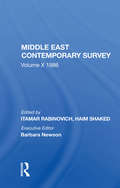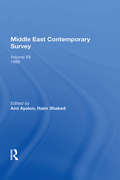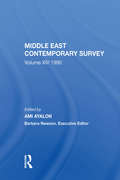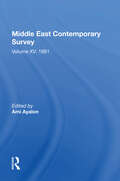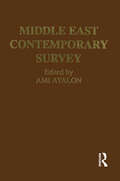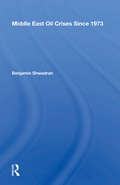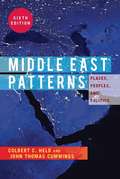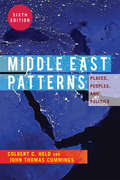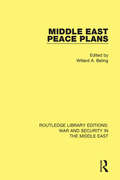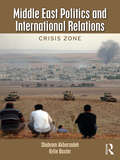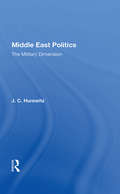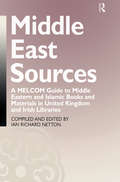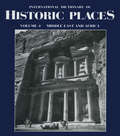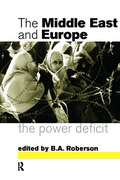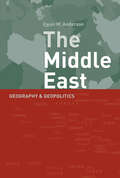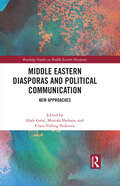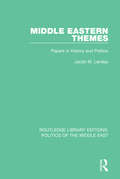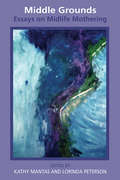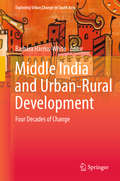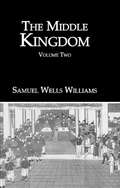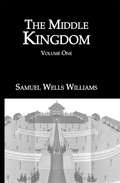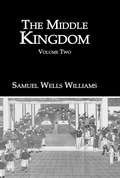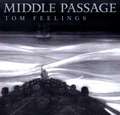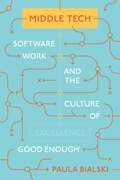- Table View
- List View
Middle East Contemporary Survey, Volume X, 1986
by Itamar RabinovichEstablished in 1977, the Middle East Contemporary Survey (MECS), a unique annual record of political developments in the Middle East, is acknowledged as the standard reference work on events and trends in the region. Designed to be a continuing, up-to-date reference for scholars, researchers and analysts, policymakers, students, and j
Middle East Contemporary Survey, Volume Xii, 1988
by Ami Ayalon Haim Shaked Barbara NewsonA unique annual record of political developments in the Middle East, the Middle East Contemporary Survey (MECS) is acknowledged as the standard reference work on events and trends in the region. Designed to be a continuing, up-to-date reference for scholars, researchers and analysts, policymakers, students, and journalists, it examines in detail the rapidly changing Middle Eastern scene in all its complexity. Each volume is divided into two parts: the first provides a series of essays on broad regional issues and on the region's foreign relations; the second offers country-by-country surveys of all the Arab states, as well as Turkey, Israel, and Iran. They elucidate the inner dynamics of each country's polity and society. Volume XII covers the year 1988-an eventful and in many ways momentous year in the Middle East. In the West Bank and Gaza, the intifada grew and conflict intensified, creating profound changes for all Palestinians, for Israel, and for the region at large. In 1988, the civilian uprising paved the way for the Palestinian declaration of independence and the concomitant boost in the PLO's international standing, generating new impetus for the long-stalemated Middle East peace process. The intifada also led to King Hussein's dissociation from the West Bank in word and deed. Among the other major themes covered in this volume are the sudden termination of the eight-year Iran-Iraq War with its domestic and regional repercussions; the Soviet withdrawal from Afghanistan after nine years of occupation; the impact of glasnost on Moscow's new political style, specifically its Middle Eastern policy; the ongoing disintegration of Lebanon; and the general elections in Israel, whose results led again to the formation of a National Unity Government.
Middle East Contemporary Survey, Volume Xiv: 1990
by Ami AyalonThis annual record of political developments in the Middle East is designed as a continuing, up-to-date reference for scholars, researchers and analysts, policy-makers, students and journalists. It examines in detail the rapidly-changing Middle-Eastern scene in all its complexity. This volume covers the eruption of the Gulf crisis and the war that had dramatic effects on all the countries of the Middle East.
Middle East Contemporary Survey, Volume Xv: 1991
by Ami AyalonThis is the fifteenth volume in a series that provides up-to-date summation and evaluation of the rapidly changing events in an exceptionally complex region of the world. This volume covers the period January through December 1991 and offers in-depth analysis of the Gulf War, the U.S.-inspired peace negotiations, the surge of Islamic sentiment in a number of countries, and inter-Arab relations in the wake of the Gulf War. In addition, a comprehensive survey of the affairs of each country is provided. This volume covers the year 1991, a watershed period in the Middle East. The Gulf War pitted regional and international forces of unprecedented might against each other in fierce confrontation. Local and global developments, such as the U.S.-led victory over Iraq and the disintegration of the Soviet Union, brought on the struggle for a new order in the region. The relevance of Western political modes for Middle Eastern societies was again raised for examination, highlighting the formidable complexities of such options. One of the local responses to these changes was a surge of Islamic sentiment sometimes militant in nature manifested primarily in Sudan, Algeria, Jordan, Egypt, and among the Palestinians. Spearheaded by the United States, the Middle East peace process entered a more dynamic phase, as a multilateral peace conference in Madrid ushered in a new era of direct Arab-Israeli negotiations. The Arab system was slow to recover from the painful impact of the Gulf War, and inter-Arab relations continued to be characterized more by mutual vindictiveness than by reconciliation. On the whole, this was a year of considerable flux and uncertainty, with some events promising the inauguration of a new course of development for the region and others passing without long-term impact. The period surveyed in this volume, unless otherwise indicated, is from January to December 1991. In order to avoid excessive repetition while achieving a comprehensive survey of the affairs of each country individually, extensive cross-references have been used
Middle East Contemporary Survey, Volume Xvi, 1992
by Ami AyalonA number of contributors explore contemporary Middle East countries and look at how and if, they have moved forward. It looks at the rise of religious extremists and the Arab-Israeli peace process, stimulated by the change of government in Israel.
Middle East Oil Crises Since 1973
by Benjamin ShwadranThe production and consumption of oil has emerged as a major factor in international economics in general and in regional and national development in particular. The struggle for access to oil and gas resources has become even more fierce, affecting the long-range strategic planning of the superpowers and causing a shift in the world balance of trade. Middle East Oil Crises Since 1973 is the logical sequel to Dr. Shwadran's classic, The Middle East, Oil and the Great Powers. In this new work, Dr. Shwadran delineates the changes in the power equation, the political atmosphere, and the resources of the participants since 1973. He marshals persuasive evidence to show that economic forces, narrow vision, and the absence of strategic planning were the major contributing factors for the oil crises of the past decade, rather than the Arab-Israeli war.
Middle East Patterns
by Colbert C. Held John Thomas CummingsNow in its sixth edition, Middle East Patterns continues to be the most comprehensive and authoritative geographical study of the region. Colbert C. Held and John Thomas Cummings introduce the Middle East from a topical perspective and then provide in-depth country-by- country coverage. The sixth edition maintains the book's well-received framework and distinctive focus on a wide range of geographical patterns-ethnographic, economic, and political-while integrating updated comparative material on natural resources and human and social development. New sections on health issues, business environments, and the historical US presence in the region expand the book's ample coverage. Richly illustrated with more than 125 photos and 70 maps, this acclaimed book remains the best accessible resource for students and general readers who seek to understand the spatial dynamics of the Middle East. Visit www.middleeastpatterns.com for historical timelines, archived content from the fifth edition, and updated material on current situations in the Middle East.
Middle East Patterns: Places, People, and Politics
by Colbert C. HeldThis book covers the Middle East from a topical or systematic perspective focusing on the states of the Gulf and southern Arabian Peninsula. It includes the dramatic developments in the Arab world across North Africa and in the heart of the Middle East since late 2010 termed as the "Arab Spring.".
Middle East Peace Plans (Routledge Library Editions: War And Security In The Middle East Ser.)
by Willard A. BelingBringing peace to the Middle East, and in particular resolving the Arab-Israeli conflict, is one of the perennial and seemingly impossible tasks of world diplomacy. Many different peace plans have been put forward by different countries; but still there has been no breakthrough. This book, first published in 1986, examines the different peace plans for the Middle East. It discusses the particular items proposed at the time, examines how the plans were put forward and shows how they got bogged down.
Middle East Politics and International Relations: Crisis Zone
by Shahram Akbarzadeh Kylie BaxterThe contemporary Middle East has been defined by political crises and conflict. The interplay of internal and external factors have set the region on a path of turmoil and crisis with devastating outcomes for its people. The absence of political accountability and representation, and policies pursued by the United States to keep US-friendly regimes in power have been two key factors that have contributed to the seemingly insoluble Middle East politics. This book provides a detailed exploration of the forces, internal and external, that have shaped today’s Middle East. The book follows a chronological order and provides context to major political milestones. Topics explored include: • Imperialism in the Middle East • The formation of the State of Israel • The Arab–Israeli wars • Palestinian politics and the failure of the ‘peace process’ • The Iranian Revolution and pan-Shi’ism • Superpowers in the Middle East • The US-led ‘War on Terror’ • The Arab uprisings • The Syrian War and the rise of the ‘Islamic State’ • US–Iran relations This study puts recent developments in historical context, and will serve as a core reference tool for students and researchers of Middle Eastern Politics and International Relations.
Middle East Politics: The Military Dimension
by J. C. HurewitzThe Arab-Israel Six Day War in June 1967 riveted world attention on the huge quantities of sophisticated weapons amassed in the arsenals of the Middle East – and left in its wake tangled political-military dilemmas and the intensification of the most dangerous arms race in the nonindustrialized world. How do major upheavals spread across borders so easily in the Middle East? What is the role of the military in the process of modernization? How can the rash of military coups be explained? Why is Israel, the most vigorous democracy in the Middle East, also the most vigorously mobilized and armed nation? J. C. Hurewitz, Professor of Government at Columbia University’s School of International Affairs, believes the answers to these and other pressing questions of Middle Eastern politics can be found only in a thorough examination of civil-military relations in each country, whether it is under military rule or not. The Middle East, as defined in this book, comprises eighteen states, stretching from Morocco to Afghanistan and Pakistan. Probing the role of the military in each state, the author assesses such other factors as the geographical and regional influences on specific national developments. Dominating all are the ramifications of the competing American and Soviet policies for the region. Through his analysis of the cold war tactics of the two Great Powers, and of the bewildering arms races and the confusion of military politics that these tactics have engendered, Professor Hurewitz brings into much clearer perspective the options for the West, and particularly for the United States, in this area. He has provided, in sum, an informative and fully documented study of the whole interplay of domestic, regional, and international politics in the postwar Middle East.
Middle East Sources: A MELCOM Guide to Middle Eastern and Islamic Books and Materials in the United Kingdom and Irish Libraries
by Ian Richard NettonMiddle East Sources provides an invaluable resource for the busy librarian, student or scholar with Middle Eastern interests. It aims to guide readers to the major collections of books and other materials on the subject in the UK and Ireland, as well as to some lesser known but nonetheless interesting collections in smaller libraries. Entries are fully up to date and include information on addresses (including telephone, fax and e-mail details), brief descriptions of collections held, along with references to relevant catalogue material and other directories.The guide also highlights the extent of collections and gives help in accessing. The MELCOM Area Specialisation Scheme (MASS) designation of the collections is also included where relevant.
Middle East and Africa: International Dictionary of Historic Places
by Trudy Ring Noelle Watson K. A. BerneyFirst Published in 1996. Routledge is an imprint of Taylor & Francis, an informa company.
Middle East and Europe: The Power Deficit
by B. A. RobersonLeading commentators on Europe and the Middle East explore many of the key issues which have informed the relationship between the two regions. Ranging from Europe's colonial legacies to an uncertain economic future in the region the book covers:* the Cold War and after* the profound influence of the US* the rise of political Islam* case studies including Europe and the Iranian revolution, France's experiences in Algeria, and Turkey's position between the two regions.The EU, it is argued, has more influence over economic strategies than security issues in the Middle East. These strategies have in turn promoted stability in the form of free trade zones, ensuring vital economic development between the Middle East and Europe.
Middle East: Geography and Geopolitics
by Ewan AndersonMiddle East is a lively and much-needed update of a well-respected work. Based on W. B. Fisher's book of the same name published in 1978, Anderson provides a comprehensive account of the physical geography which has been so instrumental to the make-up of the geopolitics of the region. The book also covers the sociology, religion, society and economy of the region. With comprehensive illustrations and maps, it provides an excellent synopsis and critique of the complexities which have made this an intriguing and important regional geographical study.
Middle Eastern Diasporas and Political Communication: New Approaches (Routledge Studies on Middle Eastern Diasporas)
by Ehab Galal Mostafa Shehata Claus Valling PedersenThis edited book explores the development and reconfiguration of Middle Eastern diasporic communities in the West in the context of increased political turmoil, civil war, new authoritarianism, and severe constraints on media in the Middle East. Taking an interdisciplinary approach, incorporating political and intercultural communication, the contributors investigate the rationale for diasporic politics, as well as the role of the transnational media in shaping diasporic political mobilization. This analysis of the media, situated within specific case studies, encompassing Afghani, Armenian, Bahraini, Egyptian, Lebanese, Syrian, Tunisian, and Turkish diasporic communities, reveals the variegated ways it influences diasporic politics and facilitates political action, as well as its influence on democratic actors residing in the Middle East. These new insights into Middle Eastern diasporas, political communication, and political mobilization are based on developments in the Middle East since 2011, and ultimately highlight how diaspora groups in the West relate to the situation in the Middle East, particularly in their countries of origin. The book is important reading for students and researchers working in political/intercultural communication and diasporic politics, as well as those with a general interest in the Middle East.
Middle Eastern Themes: Papers in History and Politics (Routledge Library Editions: Politics of the Middle East #14)
by Jacob M. LandauThis volume, first published in 1973, brings together a wide range of Professor Landau’s work on recent Middle Eastern history and politics, reflecting the breadth of the author’s concern and research. The first section deals with aspects of political organisation in the Middle East, largely Egypt, towards the end of the nineteenth century. A little-known plan of the Islamic reformer al-Afghani is discussed, showing him in a rather more political light than the religious haze which normally surrounds this pan-Islamic campaigner. The role of the influential secret societies in modern Egypt is outlined, and the politics behind the fluctuations in the degree of responsibility allowed to Egyptian ministers is examined. This section is concluded by a chapter on two proposals for the establishment of a Jewish homeland in the Sudan in the early days of Zionism, throwing interesting light on the differing aims of early Zionists and alternative historical paths that might have been taken. The second section of the book contains studies on the Jewish situation in nineteenth-century Egypt, focusing on their position within the larger Muslim society and on socio-economic factors, as well as on the career of James Sanua (‘Abu Naddara’), an Egyptian Jew who played a prominent part in nationalist agitation. The two final parts of the book turn to recent and contemporary electoral politics in the Middle East, with special attention being paid to the political leadership and voting behaviour of the Arabs in Israel. Other studies deal with elections in Lebanon and Turkey, and the final chapter analyses the militant right-wing elements in the Turkish political spectrum.
Middle Egyptian: An Introduction to the Language and Culture of Hieroglyphs
by James P. AllenMiddle Egyptian introduces the reader to the writing system of ancient Egypt and the language of hieroglyphic texts. It contains twenty-six lessons, exercises (with answers), a list of hieroglyphic signs, and a dictionary. It also includes a series of twenty-five essays on the most important aspects of ancient Egyptian history, society, religion and literature. The combination of grammar lessons and cultural essays allows users to not only read hieroglyphic texts but also to understand them, providing readers with the foundation to understand texts on monuments and to read great works of ancient Egyptian literature in the original text. This second edition contains revised exercises and essays, providing an up to date account of current research and discoveries. New illustrations enhance discussions and examples. These additions combine with the previous edition to create a complete grammatical description of the classical language of ancient Egypt for specialists in linguistics and other fields.
Middle Grounds: Essays on Midlife Mothering
by Kathy MantasAlthough motherhood writings are rich and emerging, the available literature on midlife motherhood and mothering is incomplete and often presented from a narrow perspective. Middle Grounds: Essays on Midlife Mothering fills this gap, widening the lens on a sociological phenomenon that is expanding in the twenty first century. It brings together scholarly and creative essays from diverse disciplines and cultural perspectives to reflect a more contemporary viewpoint — that motherhood and mothering is not limited by the stages of life or chronological age. It echoes distinct voices speaking about experiences that represent a global reality for midlife mothering practices. In essence, this collection demonstrates that everything can transpire in the middle period of a woman’s life. Thus, in midlife, we encounter a broad range of mothering experiences and practices, and ways of rep- resenting and expressing them
Middle India and Urban-Rural Development: Four Decades of Change (Exploring Urban Change in South Asia)
by Barbara Harriss-WhiteMiddle India and Rural-Urban Development explores the socio-economic conditions of an ‘India’ that falls between the cracks of macro-economic analysis, sectoral research and micro-level ethnography. Its focus, the ‘middle India’ of small towns, is relatively unknown in scholarly terms for good reason: it requires sustained and difficult field research. But it is where most Indians either live or constantly visit in order to buy and sell, arrange marriages and plot politics. Anyone who wants to understand India therefore needs to understand non-metropolitan, provincial, small-town India and its economic life. This book meets this need. From 1973 to the present, Barbara Harriss-White has watched India’s development through the lens of an ordinary town in northern Tamil Nadu, Arni. This book provides a pluralist, multi-disciplinary and inter-disciplinary perspective on Arni and its rural hinterland. It grounds general economic processes in the social specificities of a given place and region. In the process, continuity is juxtaposed with abrupt change. A strong feature of the book is its analysis of how government policies that fail to take into account the realities of small town life in India have unintended and often perverse consequences. In this unique book, Harriss-White brings together ten essays written by herself and her research team on Arni and its surrounding rural areas. They track the changing nature of local business and the workforce; their urban-rural relations, their regulation through civil society organizations and social practices, their relations to the state and to India’s accelerating and dynamic growth. That most people live outside the metropolises holds for many other developing countries and makes this book, and the ideas and methods that frame it, highly relevant to a global development audience.
Middle Kingdom 2 Vol Set: A Survey Of The Geog
by WilliamsPublished in the year 2006, Middle Kingdom 2 Vol Set is a valuable contribution to the field of Social Science and Anthropology.
Middle Kingdom Vol 1: A Survey Of The ... Chinese Empire And Its Inhabitants ...
by WilliamsFirst published in 2009. Routledge is an imprint of Taylor & Francis, an informa company.
Middle Kingdom Vol 2: A Survey Of The Geog
by WilliamsFirst published in 2009. Routledge is an imprint of Taylor & Francis, an informa company.
Middle Passage: White Ships/ Black Cargo
by Tom Feelings John Henrik ClarkeThe Middle Passage is the name given to one of the most tragic ordeals in history: the cruel and terrifying journey of enslaved Africans across the Atlantic Ocean. <P><P> In this seminal work, master artist Tom Feelings tells the complete story of this horrific diaspora in sixty-four extraordinary narrative paintings. Achingly real, they draw us into the lives of the millions of African men, women, and children who were savagely torn from their beautiful homelands, crowded into disease-ridden "death ships", and transported under nightmarish conditions to the so-called New World. <P> An introduction by noted historian Dr. John Henrik Clarke traces the roots of the Atlantic slave trade and gives a vivid summary of its four centuries of brutality. The Middle Passage reaches us on a visceral level. No one can experience it and remain unmoved. But while we absorb the horror of these images, we also can find some hope in them. They are a tribute to the survival of the human spirit, and the humanity won by the survivors of the Middle Passage belongs to us all.<P>Winner of the Coretta Scott King Medal
Middle Tech: Software Work and the Culture of Good Enough (Princeton Studies in Culture and Technology #36)
by Paula BialskiWhy software isn&’t perfect, as seen through the stories of software developers at a run-of-the-mill tech companyContrary to much of the popular discourse, not all technology is seamless and awesome; some of it is simply &“good enough.&” In Middle Tech, Paula Bialski offers an ethnographic study of software developers at a non-flashy, non-start-up corporate tech company. Their stories reveal why software isn&’t perfect and how developers communicate, care, and compromise to make software work—or at least work until the next update. Exploring the culture of good enoughness at a technology firm she calls &“MiddleTech,&” Bialski shows how doing good-enough work is a collectively negotiated resistance to the organizational ideology found in corporate software settings.The truth, Bialski reminds us, is that technology breaks due to human-related issues: staff cutbacks cause media platforms to crash, in-car GPS systems cause catastrophic incidents, and chatbots can be weird. Developers must often labor to patch and repair legacy systems rather than dream up killer apps. Bialski presents a less sensationalist, more empirical portrait of technology work than the frequently told Silicon Valley narratives of disruption and innovation. She finds that software engineers at MiddleTech regard technology as an ephemeral object that only needs to be good enough to function until its next iteration. As a result, they don&’t feel much pressure to make it perfect. Through the deeply personal stories of people and their practices at MiddleTech, Bialski traces the ways that workers create and sustain a complex culture of good enoughness.
